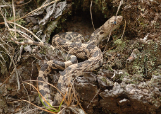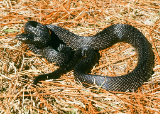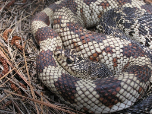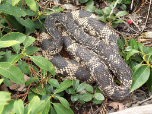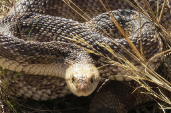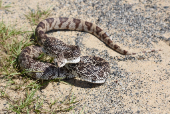|
Pine Snake (Pituophis melanoleucus)
Description: Adults are large, growing to 48–90 inches in total length (including tail) and are powerfully built. The head is small and somewhat pointed with an enlarged rostral scale that extends upward between the internasal scales. Usually, four prefrontal scales are seen. At midbody are 27-37 rows of keeled dorsal scales. The anal plate is single.[9] The color pattern consists of a light ground color overlaid with black, brown, or reddish-brown blotches.
Habitat: The pine snake inhabits pine flatwoods, sandy pine-oak woodlands, prairies, cultivated field, open brushland, rocky desert and chaparral. It occurs from sea level to an elevation of 9,000 feet. The pine snake requires well-drained, sandy soils with little vegetation for use as nesting and hibernation sites. P. melanoleucus communities in New Jersey were found to hibernate communally while communities in other regions like Tennessee were found to hibernate on their own.
Range: The species P. melanoleucus is found in the United States in Alabama, Florida, Georgia, Kentucky, Louisiana, Mississippi, New Jersey, North Carolina, South Carolina, Tennessee, Delaware and Virginia. The nominate subspecies occurs in southern New Jersey, southern North Carolina west through South Carolina to northern Georgia, eastern Tennessee, southeastern Kentucky and south into Alabama. P. m. lodingi occurs from southwestern Alabama to eastern Louisiana, overlapping with P. m. mugitus from southern South Carolina to Georgia and southern Florida.
Diet: The pine snake preys on rats, mice, moles and other small mammals and eggs. It often enters rodent burrows in search of a meal. In these cases, multiple kills are frequent, with the snake pressing the mice against the walls of the burrow.
Reproduction: After mating has taken place in spring, clutches of three to 24 eggs are laid in June–August. The eggs are deposited in sandy burrows or under large rocks or logs and hatch after 64–79 days of incubation. They are known to build communal nests, with several females laying eggs in the same spot. The eggs are adherent and quite large, up to 2.6 inches long by 1.8 inches wide. Hatchlings measure 13 to 18 inches. Eggs laid on wetter substrate tended to produce larger hatchlings than those laid on dryer substrate.
Status: The pine snake is classified as least concern on the IUCN Red List, due to its wide distribution and large number of subpopulations; while the total populations appears to be declining, this is likely happening at a slow rate. However, the species is thought to be impacted by continued habitat degradation and destruction. It is present in a variety of protected areas. Habitat loss is the major threat to populations of this species. Construction of hibernacula is an effective tool for enhancing the survival rates of the species.
»» Kingdom: Animalia - Animals
»» Phylum: Chordata - Chordates
»» Subphylum: Vertebrata - Vertebrates
»» Class: Reptilia - Reptiles
»» Order: Squamata - Scaled Reptiles
»» Suborder: Serpentes
»» Superfamily: Colubroidea
»» Family: Colubridae - Colubrids
»» Genus: Pituophis
»» Species: Pituophis melanoleucus - Pine Snake
This article uses material from the Wikipedia article "Pituophis melanoleucus", which is released under the Creative Commons Attribution-Share-Alike License 3.0. Content may have been omitted from the original, but no content has been changed or extended.
|
|


